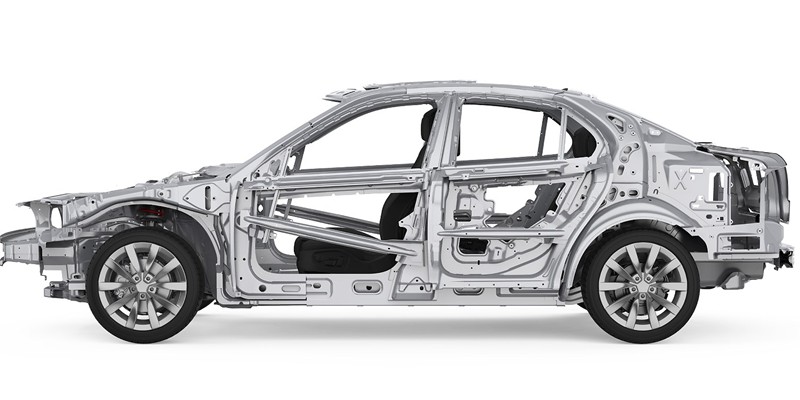A car frame is the structural backbone of a vehicle, providing support, rigidity, and a foundation for mounting other components like the engine, suspension, and body. It ensures stability, safety, and handling while absorbing and distributing forces during operation. Below is a detailed explanation of car frame types, functions, and manufacturing methods.

Types of Car Frames
Car frames vary based on design, vehicle type, and intended use. The main types include:
- Ladder Frame:
- Description: A simple, robust structure resembling a ladder with two longitudinal rails connected by cross-members.
- Use: Common in trucks, SUVs, and off-road vehicles due to its durability and ability to handle heavy loads.
- Advantages: Strong, easy to manufacture, and repairable; supports heavy-duty applications.
- Disadvantages: Heavy, less rigid against twisting forces, not ideal for high-speed handling.
- Unibody (Monocoque) Frame:
- Description: The body and frame are integrated into a single structure, with the chassis and body panels sharing load-bearing duties.
- Use: Standard in most modern passenger cars and crossovers for its lightweight design and fuel efficiency.
- Advantages: Lightweight, better fuel economy, improved handling, and efficient use of space.
- Disadvantages: Costly to repair, less durable for extreme off-road conditions.
- Space Frame:
- Description: A three-dimensional framework of tubular or beam structures forming a rigid cage, often made of lightweight materials like aluminum.
- Use: Found in sports cars, race cars, and some high-performance vehicles (e.g., supercars).
- Advantages: High strength-to-weight ratio, excellent rigidity, and customizable design.
- Disadvantages: Complex and expensive to manufacture.
- Backbone Frame:
- Description: A single, strong central tube (backbone) connects the front and rear axles, with the body mounted around it.
- Use: Used in some niche vehicles like certain sports cars or small trucks (e.g., older Lotus models).
- Advantages: Lightweight, simple design, and good torsional rigidity.
- Disadvantages: Limited load-carrying capacity, less common in modern vehicles.
- Platform Frame:
- Description: A hybrid between unibody and ladder frame, where a flat platform serves as the base for mounting body and components.
- Use: Seen in some older vehicles or specific modular designs.
- Advantages: Versatile for multiple vehicle types, relatively simple to modify.
- Disadvantages: Heavier than unibody, less common today.
- Subframe:
- Description: A smaller frame attached to a unibody or ladder frame to support specific components like the engine or suspension.
- Use: Common in modern vehicles to improve modularity and reduce vibrations.
- Advantages: Enhances rigidity, isolates vibrations, and simplifies assembly.
- Disadvantages: Adds weight and complexity.
Functions of a Car Frame
The car frame serves several critical roles:
- Structural Support: Provides a foundation for mounting components like the engine, transmission, suspension, and body panels.
- Load Distribution: Distributes the vehicle’s weight and external forces (e.g., road impacts, cargo weight) to maintain stability.
- Safety: Absorbs and dissipates crash energy in unibody designs, protecting occupants through crumple zones.
- Rigidity and Handling: Ensures torsional and bending rigidity for precise handling and ride comfort.
- Vibration and Noise Reduction: Subframes and structural reinforcements minimize vibrations and noise for a smoother ride.
- Alignment: Maintains proper alignment of wheels and suspension for consistent performance and tire wear.
Manufacturing Methods
Car frames are manufactured using various techniques, depending on the frame type, material, and production scale. Common methods include:
- Stamping:
- Process: Sheet metal (usually steel or aluminum) is pressed into shape using dies in a stamping press to form frame components or body panels.
- Application: Widely used for unibody frames and body panels in mass production.
- Advantages: High precision, cost-effective for large-scale production.
- Disadvantages: High initial tooling costs, limited to simpler shapes.
- Welding:
- Process: Frame components (e.g., steel or aluminum tubes, panels) are joined using techniques like MIG, TIG, or spot welding.
- Application: Common in ladder frames, space frames, and unibody construction.
- Advantages: Strong joints, versatile for various frame types.
- Disadvantages: Labor-intensive, requires skilled workers for high-quality welds.
- Hydroforming:
- Process: High-pressure fluid shapes metal tubes into complex forms inside a mold, creating lightweight, strong components.
- Application: Used for space frames and some unibody components, especially in high-performance vehicles.
- Advantages: Produces complex shapes with fewer welds, lightweight, and strong.
- Disadvantages: Expensive equipment and slower process.
- Casting:
- Process: Molten metal (e.g., aluminum) is poured into molds to create frame components, such as subframe or suspension mounts.
- Application: Common for specific parts in unibody or space frames.
- Advantages: Allows complex geometries, good for lightweight materials like aluminum.
- Disadvantages: High cost for large components, potential for defects.
- Roll Forming:
- Process: Metal strips are passed through rollers to form continuous profiles, like beams or rails.
- Application: Used for ladder frame rails or structural reinforcements.
- Advantages: Efficient for long, uniform sections; cost-effective.
- Disadvantages: Limited to simple, linear shapes.
- Additive Manufacturing (3D Printing):
- Process: Layers of metal or composite materials are built up to create complex frame components.
- Application: Emerging in prototype frames or niche parts for high-performance vehicles.
- Advantages: High customization, reduced material waste.
- Disadvantages: Slow, expensive, and not yet scalable for mass production.
Materials Used
- Steel: High-strength steel is common for ladder and unibody frames due to its durability and cost-effectiveness.
- Aluminum: Used in space frames and some unibody designs for weight reduction (e.g., Audi A8, Tesla Model S).
- Carbon Fiber: Rare, used in high-end sports cars for lightweight, high-strength frames (e.g., McLaren models).
- Composites: Emerging in niche applications for weight savings and corrosion resistance.
Conclusion
The Car frame is a critical component that defines a vehicle’s strength, safety, and performance. Ladder frames suit heavy-duty vehicles, while unibody frames dominate passenger cars for their efficiency. Manufacturing methods like stamping, welding, and hydroforming balance cost, strength, and complexity. Advances in materials and techniques, like aluminum and additive manufacturing, continue to evolve frame design for better performance and sustainability.

